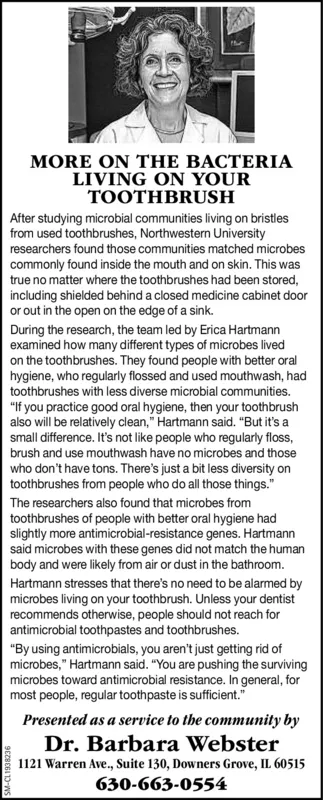Advertisement

-
Published Date
December 23, 2021This ad was originally published on this date and may contain an offer that is no longer valid. To learn more about this business and its most recent offers, click here.
Ad Text
MORE ON THE BACTERIA LIVING ON YOUR TOOTHBRUSH After studying microbial communities living on bristles from used toothbrushes, Northwestern University researchers found those communities matched microbes commonly found inside the mouth and on skin. This was true no matter where the toothbrushes had been stored, including shielded behind a closed medicine cabinet door or out in the open on the edge of a sink. During the research, the team led by Erica Hartmann examined how many different types of microbes lived on the toothbrushes. They found people with better oral hygiene, who regularly flossed and used mouthwash, had toothbrushes with less diverse microbial communities. "If you practice good oral hygiene, then your toothbrush also will be relatively clean," Hartmann said. "But it's a small difference. It's not like people who regularly floss, brush and use mouthwash have no microbes and those who don't have tons. There's just a bit less diversity on toothbrushes from people who do all those things." The researchers also found that microbes from toothbrushes of people with better oral hygiene had slightly more antimicrobial-resistance genes. Hartmann said microbes with these genes did not match the human body and were likely from air or dust in the bathroom. Hartmann stresses that there's no need to be alarmed by microbes living on your toothbrush. Unless your dentist recommends otherwise, people should not reach for antimicrobial toothpastes and toothbrushes. "By using antimicrobials, you aren't just getting rid of microbes," Hartmann said. "You are pushing the surviving microbes toward antimicrobial resistance. In general, for most people, regular toothpaste is sufficient." Presented as a service to the community by Dr. Barbara Webster 1121 Warren Ave., Suite 130, Downers Grove, IL 60515 630-663-0554 9EZBEGI1D-WS MORE ON THE BACTERIA LIVING ON YOUR TOOTHBRUSH After studying microbial communities living on bristles from used toothbrushes, Northwestern University researchers found those communities matched microbes commonly found inside the mouth and on skin. This was true no matter where the toothbrushes had been stored, including shielded behind a closed medicine cabinet door or out in the open on the edge of a sink. During the research, the team led by Erica Hartmann examined how many different types of microbes lived on the toothbrushes. They found people with better oral hygiene, who regularly flossed and used mouthwash, had toothbrushes with less diverse microbial communities. "If you practice good oral hygiene, then your toothbrush also will be relatively clean," Hartmann said. "But it's a small difference. It's not like people who regularly floss, brush and use mouthwash have no microbes and those who don't have tons. There's just a bit less diversity on toothbrushes from people who do all those things." The researchers also found that microbes from toothbrushes of people with better oral hygiene had slightly more antimicrobial-resistance genes. Hartmann said microbes with these genes did not match the human body and were likely from air or dust in the bathroom. Hartmann stresses that there's no need to be alarmed by microbes living on your toothbrush. Unless your dentist recommends otherwise, people should not reach for antimicrobial toothpastes and toothbrushes. "By using antimicrobials, you aren't just getting rid of microbes," Hartmann said. "You are pushing the surviving microbes toward antimicrobial resistance. In general, for most people, regular toothpaste is sufficient." Presented as a service to the community by Dr. Barbara Webster 1121 Warren Ave., Suite 130, Downers Grove, IL 60515 630-663-0554 9EZBEGI1D-WS
